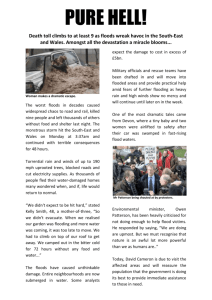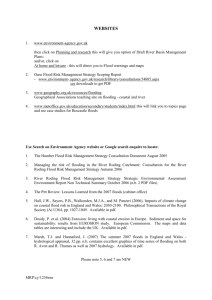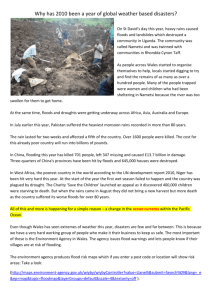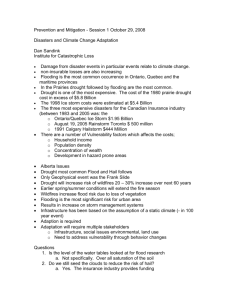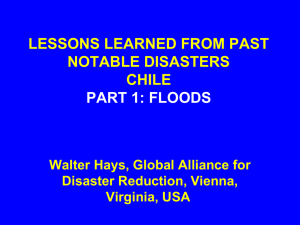Why has 2010 been a year of global weather
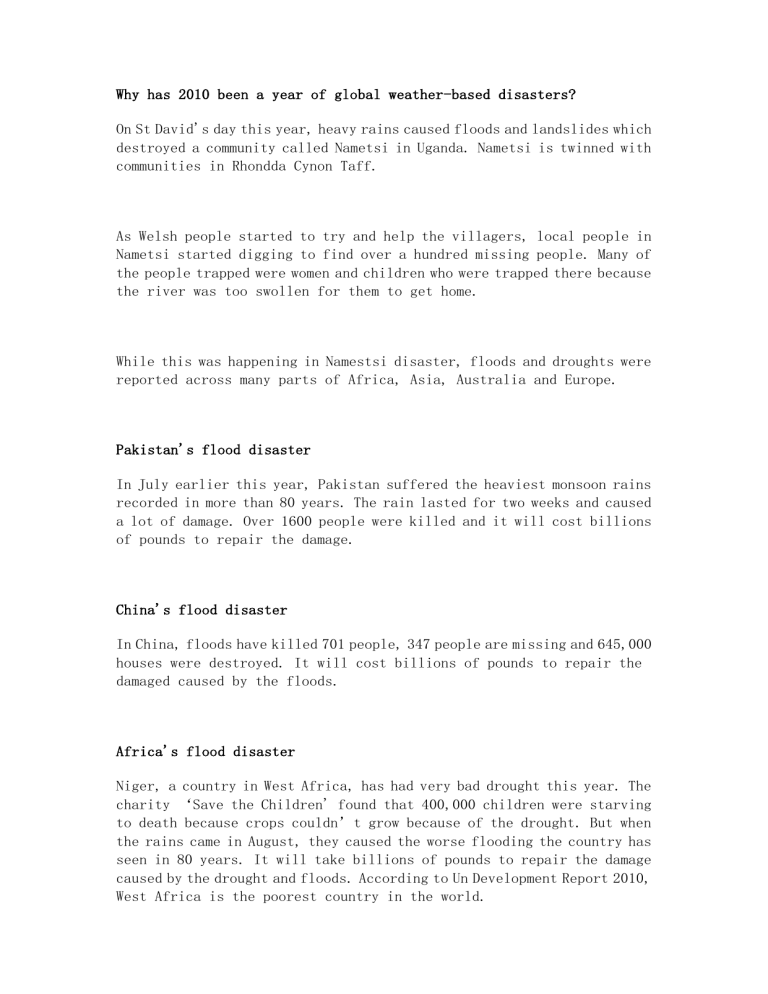
Why has 2010 been a year of global weather-based disasters?
On St David's day this year, heavy rains caused floods and landslides which destroyed a community called Nametsi in Uganda. Nametsi is twinned with communities in Rhondda Cynon Taff.
As Welsh people started to try and help the villagers, local people in
Nametsi started digging to find over a hundred missing people. Many of the people trapped were women and children who were trapped there because the river was too swollen for them to get home.
While this was happening in Namestsi disaster, floods and droughts were reported across many parts of Africa, Asia, Australia and Europe.
Pakistan's flood disaster
In July earlier this year, Pakistan suffered the heaviest monsoon rains recorded in more than 80 years. The rain lasted for two weeks and caused a lot of damage. Over 1600 people were killed and it will cost billions of pounds to repair the damage.
China's flood disaster
In China, floods have killed 701 people, 347 people are missing and 645,000 houses were destroyed. It will cost billions of pounds to repair the damaged caused by the floods.
Africa's flood disaster
Niger, a country in West Africa, has had very bad drought this year. The charity ‘Save the Children' found that 400,000 children were starving to death because crops couldn’t grow because of the drought. But when the rains came in August, they caused the worse flooding the country has seen in 80 years. It will take billions of pounds to repair the damage caused by the drought and floods. According to Un Development Report 2010,
West Africa is the poorest country in the world.
Why have there been so many weather disasters around the world this year?
All of this and more is happening for a simple reason: a change in the ocean currents within the Pacific Ocean.
Did you know?
Under normal conditions the winds in the Pacific Ocean drive warm surface water westwards where it ‘piles up' around Australia and Indonesia. This allows cold water off the coast of South America to rise to the surface.
This causes warm moist air in the west and colder drier air in the east.
If the winds weaken above the Pacific Ocean, the warm water in the west flows towards the east. This causes heavy rains in South America and droughts in places like Australia. The local fishermen in Peru called these weather conditions El Ni_o. This happened in December - March in
2010 causing the climate disasters around the world at the start of the year.
After El Ni_o the winds did not go back to normal but became much stronger than normal. So even more warm water than usual was piled up in the west of the Pacific and it was this that helped trigger the floods in July and
August. These conditions are called La Ni_a by the local fishermen.
What about Wales?
In Wales weather disasters like the ones in Pakistan and Africa are rare and happen on a much smaller scale. This is the people at Environment
Agency in Wales work very hard to keep us safe. The Agency warns people about flood warnings and if their homes and businesses are at risk of flooding.
You can register your address on their website and they will let you know if your village or town is at risk of flooding. They will send you a text, email or leave a voice message for you. Why not enter your postcode?
Probably the most visible activities of the Environment Agency in Wales are the flood schemes to prevent flooding across Wales. Check out their website to find out about current flood protection schemes in Fairbourne,
Abergele, Dolgellau, Afon Rhyd-hir, Pwllheli, Bangor-on-Dee, Caersws,
Chepstow, Conwy Valley, Hereford, Llandovery, Llanfyllin, Meifod,
Rhydymwyn and Rossett.
Decision Making Exercise
Find out about the risk of flooding in and around where you live or go to school. Use the Environment Agency Website to help you
Look at different flood schemes in Wales and make a decision on what aspects of other schemes would work in your local area

